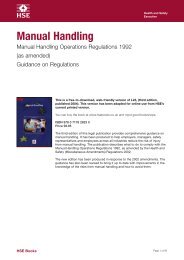Making Companies Safe - what works? (CCA ... - Unite the Union
Making Companies Safe - what works? (CCA ... - Unite the Union
Making Companies Safe - what works? (CCA ... - Unite the Union
Create successful ePaper yourself
Turn your PDF publications into a flip-book with our unique Google optimized e-Paper software.
perceived low level of current fines, is reducing <strong>the</strong> deterrent of prosecutions.<br />
Most interviewees consider increased prosecution of directors, under corporate<br />
manslaughter, would lead to improvements in health and safety.” 51<br />
Uneven Enforcement<br />
There is also evidence to suggest that a failure to enforce certain regulations, or even<br />
specific provisions within certain regulations, can lead to widespread non-compliance. For<br />
instance, studies of <strong>the</strong> construction industry suggest that <strong>the</strong> majority of clients lack<br />
commitment to occupational health and safety, and fail to comply with <strong>the</strong>ir legal obligations<br />
under <strong>the</strong> Construction (Design and Management) Regulations 1994 (CDM). 52 Concern has<br />
also been expressed that designers commonly fail to comply with <strong>the</strong>ir duties under <strong>the</strong> CDM<br />
Regulations. 53 Interview and incident data suggest that this lack of commitment from clients<br />
and designers is a major cause of <strong>the</strong> industry’s poor OHS record. 54 For instance, three<br />
quarters of <strong>the</strong> respondents to <strong>the</strong> HSE’s 2002 discussion document ‘Revitalising Health and<br />
<strong>Safe</strong>ty in Construction’, saw client’s lack of commitment to health and safety and negative<br />
influence at <strong>the</strong> tender stage as <strong>the</strong> main challenge to improved health and safety standards. 55<br />
An analysis of prosecution data from <strong>the</strong> HSE’s enforcement database confirms <strong>the</strong><br />
widespread perception that prosecutions of clients and designers under <strong>the</strong> CDM Regulations<br />
are relatively infrequent. 56 Between 1 April 1999 and 31 August 2004 <strong>the</strong> HSE prosecuted<br />
1195 breaches of health and safety regulations where <strong>the</strong> defendents were involved in<br />
construction activity. 147 of <strong>the</strong>se involved breaches of <strong>the</strong> CDM Regulations. Of <strong>the</strong>se, <strong>the</strong>re<br />
were 78 breaches where <strong>the</strong> duty holder prosecuted was a client and only 9 where <strong>the</strong> duty<br />
holder was a designer.<br />
Recent survey data from <strong>the</strong> UK suggests that <strong>the</strong> lack of commitment exhibited by clients is<br />
caused, amongst o<strong>the</strong>r things, by <strong>the</strong> low level of prosecutions against clients for breach of<br />
<strong>the</strong>ir duties under <strong>the</strong> CDM Regulations, combined with insubstantial fines. 57 In addition, a<br />
National Audit Office (NAO) review of an HSE initiative to influence designers found that some<br />
designers <strong>the</strong>mselves believed that only <strong>the</strong> issue of improvement and prohibition notices<br />
would generate improvements. 58 Consequently one of <strong>the</strong> recommendations made by <strong>the</strong><br />
NAO is that HSE could increase <strong>the</strong> impact of initiatives by “increasing enforcement action<br />
with designers”. 59 As stated earlier, <strong>the</strong> low levels of prosecution under <strong>the</strong> CDM Regulations<br />
are surprising in view of <strong>the</strong> fact that earlier HSE-commissioned research had recommended<br />
that: <strong>the</strong> duties of clients should be made more explicit, that <strong>the</strong>se duties should be strictly<br />
enforced, and that penalties for non-compliance should be substantial. 60<br />
1 Health and <strong>Safe</strong>ty Commission (2004a: 11).<br />
2 Health and <strong>Safe</strong>ty Executive (2003a).and meeting held by <strong>CCA</strong> with Head of HSE’s Construction Division.<br />
3 Health and <strong>Safe</strong>ty Commission (2004a: 8).<br />
4 Health and <strong>Safe</strong>ty Executive (2003a).<br />
5 Health and <strong>Safe</strong>ty Executive (2003a).<br />
6 See HSC’s ‘Enforcement Policy Statement” 2000, and Enforcement Management Model.<br />
7 Health and <strong>Safe</strong>ty Executive (2003a).<br />
8 Cosman (1999), discussed in Hillage et al. (2001: 30).<br />
9 (Hussain and Willday, 2000).<br />
10 Rakel et al. (1999).<br />
11 Wright et al. (2004: vi), and see also Health and <strong>Safe</strong>ty Commission (2003a: Annex 3).<br />
12 Wright (1998).<br />
13 Wright (1998: 32).<br />
14 Health and <strong>Safe</strong>ty Commission (2003a: 3).<br />
15 Wright et al. (2004: 73).<br />
16 Thomson-MTS (1993a: 87).<br />
17 Gunningham (1999a: 15). See also McQuiston et al. (1998).<br />
18 Lewis-Beck and Alford (1980). Discussed in Gunningham and Johnstone (1999: 233, endnote 38).<br />
19 Perry (1982: 303).<br />
20 Gray and Scholz (1993).<br />
21 Baggs et al. (2003).<br />
22 Hopkins (1995); Gray (1996); Shapiro and Rabinowtiz (1997): 722. 47
















